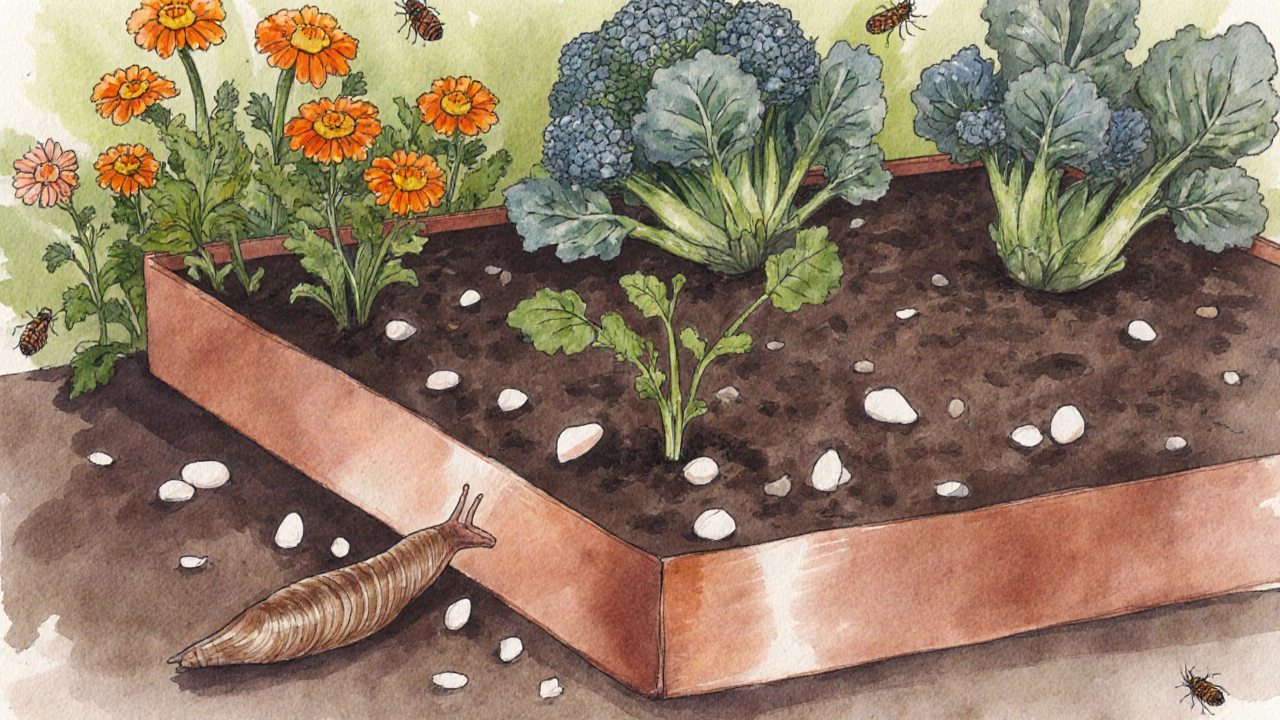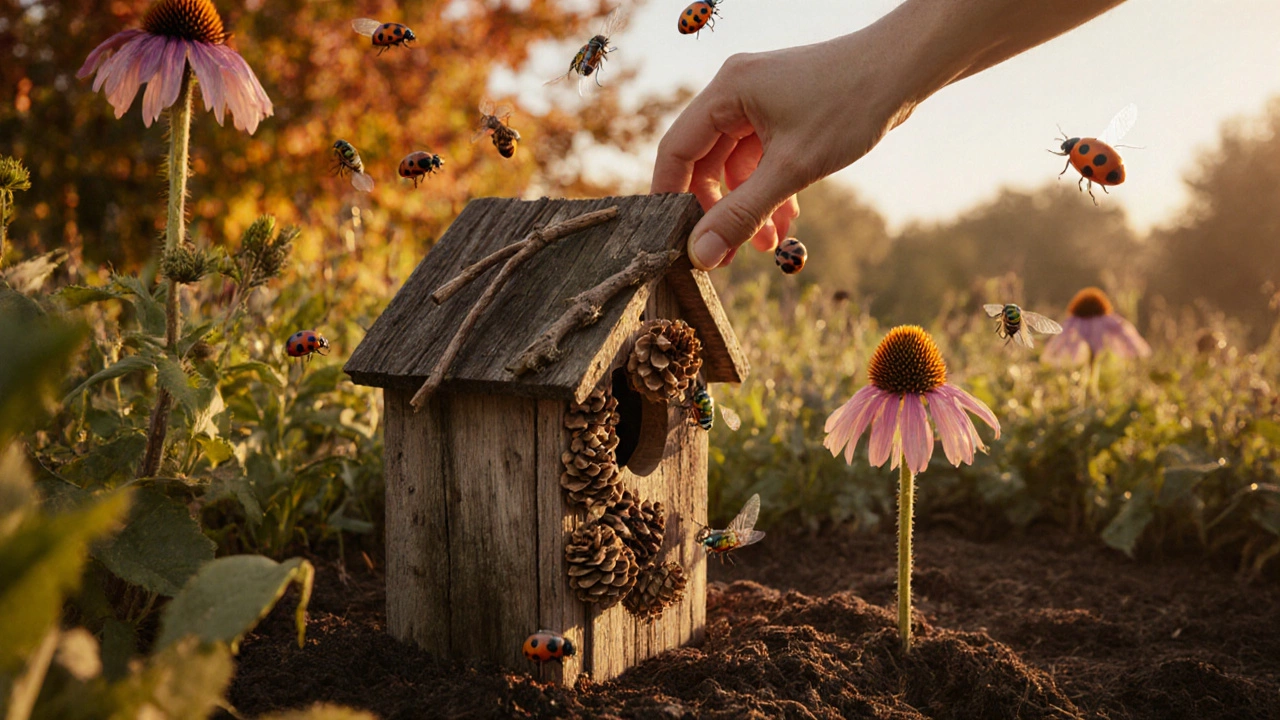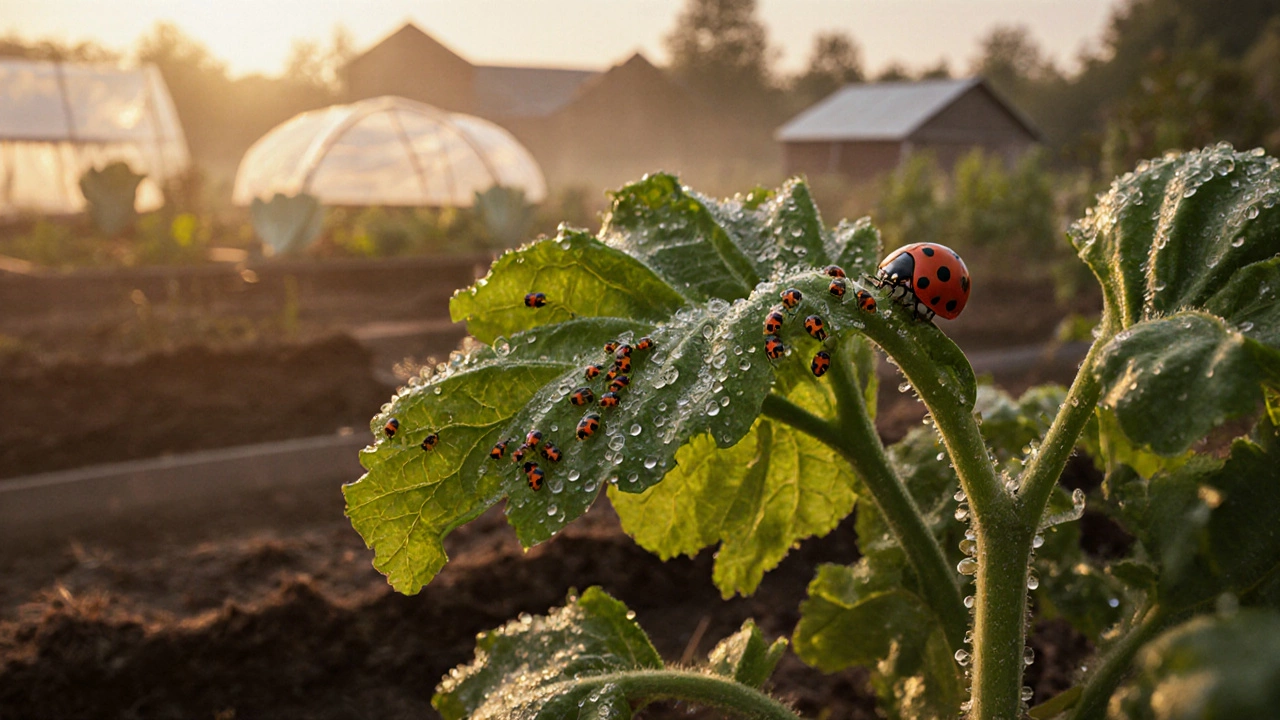Garden Pest Identifier
Identify What's Eating Your Plants
Describe the symptoms you're seeing to find out which pests are likely causing damage. This tool will help you identify the problem so you can use the right natural solution from the article.
Nothing kills the joy of growing your own vegetables faster than waking up to chewed-up lettuce, holes in tomato leaves, or entire seedlings gone overnight. If you’ve ever stared at your garden and wondered how to keep bugs from eating your vegetable garden, you’re not alone. The good news? You don’t need chemicals, expensive sprays, or fancy gadgets. Most gardeners in the UK, including those in Brighton’s damp climate, solve this problem with simple, natural methods that actually work.
Know Your Enemy Before You Fight It
Not all bugs are bad. Ladybugs, lacewings, and ground beetles are your friends-they eat aphids, mites, and caterpillars. The real troublemakers are the ones that target your crops: aphids, cabbage worms, flea beetles, slugs, snails, and tomato hornworms. Each leaves a different signature.Aphids cluster on the undersides of leaves and leave sticky residue. Cabbage worms are green and hide inside broccoli or cabbage heads. Flea beetles make tiny shot-holes in leaves. Slugs leave slimy trails and eat whole seedlings overnight. If you don’t know what’s eating your plants, you’ll waste time spraying the wrong thing.
Check your plants every other day, especially in the morning or evening. Look under leaves. Use a magnifying glass if you have one. Take a photo of the bug or damage and compare it to online guides from the Royal Horticultural Society. Identifying the pest correctly cuts your solution time in half.
Use Physical Barriers That Actually Work
One of the most underrated tools in pest control is a simple piece of fabric. Row covers-lightweight, breathable polyester fabric-are a game-changer. Drape them over your brassicas (cabbage, kale, broccoli) right after planting. They block cabbage moths from laying eggs, keep flea beetles away, and protect young plants from wind and frost too.For slugs and snails, try copper tape around the edges of raised beds. It gives them a mild electric shock when they try to cross. You can buy it online or cut strips from copper piping. Another trick: sprinkle crushed eggshells or diatomaceous earth around plants. Both are sharp to soft-bodied pests and deter them from crawling up.
Don’t forget netting. Protect your carrots and onions from carrot flies by covering them with fine mesh. Carrot flies fly low-just 30cm above the soil-so even a 40cm-high barrier works. Make sure the netting is sealed at the edges so pests can’t sneak in.
Plant Smart: Companion Planting That Repels Bugs
Your garden doesn’t have to be all vegetables. Mixing in certain flowers and herbs confuses pests and attracts their predators. This isn’t magic-it’s biology.Plant marigolds around your tomatoes. They release a scent that repels nematodes and whiteflies. Nasturtiums act as a trap crop for aphids-they love nasturtiums more than your cabbage, so the bugs stay put there. Plant garlic or chives near roses and brassicas. Their strong smell masks the scent of your veggies, making it harder for pests to find them.
Try intercropping: plant rows of carrots alongside onions. The smell of onions deters carrot flies, and carrots loosen the soil for onions. Basil planted near tomatoes keeps aphids and thrips away and even improves tomato flavor. These combinations aren’t just pretty-they’re practical.

Make Your Own Natural Sprays
Sometimes you need to act fast. If aphids are taking over your beans or caterpillars are munching your kale, a homemade spray can stop them in days.For aphids and soft-bodied insects: mix 1 tablespoon of mild liquid soap (like Castile soap) with 1 litre of water. Spray directly on the bugs, not the whole plant. Do this in the early morning or late afternoon to avoid burning leaves in the sun. Reapply every 3-4 days until the bugs are gone.
For caterpillars and beetles: blend 2 garlic bulbs, 1 small onion, and 1 teaspoon of cayenne pepper with 500ml of water. Let it sit overnight, strain it, then add 1 litre of water and a few drops of soap. Spray on affected plants. This stinks to bugs-but not to you after it dries.
Neem oil is another option. It’s a natural pesticide derived from the neem tree. Mix 5ml of neem oil with 1 litre of water and a few drops of soap. Spray every 7-10 days. It disrupts insect feeding and reproduction without harming bees or ladybugs.
Keep Your Garden Clean and Healthy
Pests love clutter. Dead leaves, rotting plant debris, and overgrown weeds are bug hotels. Clean up your garden at the end of each season. Remove all tomato stalks, cabbage stumps, and fallen fruit. Compost them only if you’re sure they’re pest-free-otherwise, bin them.Rotate your crops every year. Don’t plant tomatoes where tomatoes grew last year. Same with brassicas or potatoes. Pests overwinter in the soil and come back to the same spot. Rotating breaks their life cycle.
Healthy plants resist pests better. Make sure your soil isn’t compacted. Add compost every spring. Water at the base, not the leaves-wet foliage invites mildew and attracts pests like spider mites. Mulch with straw or wood chips to keep the soil moist and stop weeds from hiding bugs.
Attract the Right Bugs
You don’t have to fight every bug-you can hire some. Beneficial insects are nature’s pest control team.Plant flowers like yarrow, dill, fennel, and cosmos. These attract hoverflies, parasitic wasps, and ladybugs. A single ladybug can eat 5,000 aphids in its lifetime. If you see them in your garden, don’t spray. Let them do their job.
Build a bug hotel: stack hollow stems, pine cones, and bricks with small gaps. Place it near your veggie beds. Solitary bees and ground beetles will move in and help control pests. You don’t need a fancy structure-just a pile of natural materials in a quiet corner.

What Doesn’t Work (And Why)
There are a lot of myths out there. Vinegar sprays? They burn plant leaves and kill beneficial microbes in the soil. Baking soda? It doesn’t kill bugs-it might help with fungal diseases, but not insects. Coffee grounds? They don’t repel slugs. The myth started because coffee grounds are acidic, but slugs crawl right over them.Chemical pesticides? They kill everything, including bees and earthworms. They also make pests stronger over time. A few sprays might wipe out the current population, but resistant bugs come back worse. Stick to natural methods-they’re safer, cheaper, and build long-term balance in your garden.
Seasonal Tips for UK Gardeners
In Brighton, spring is damp and cool. That’s when slugs and aphids thrive. Start your barriers early-row covers on brassicas by late March. In summer, watch for tomato hornworms. Handpick them off at dusk with gloves-they’re big and obvious.Autumn is cleanup time. Remove all plant debris. Mulch your beds with compost to feed the soil and hide overwintering pests. In winter, leave some seed heads (like echinacea or sunflowers) standing. Birds eat the seeds and also pick off overwintering insects.
Keep a garden journal. Note what pests showed up, when, and what worked. Next year, you’ll know exactly when to act.
Why are bugs eating my vegetables but not my flowers?
Many bugs are picky eaters. Cabbage worms only eat brassicas, aphids prefer soft new growth like beans and tomatoes, and slugs love lettuce and seedlings. Flowers often have strong scents or tough leaves that pests avoid. That’s why companion planting works-it uses those natural repellents to protect your veggies.
Is it okay to use insecticidal soap on edible plants?
Yes, if it’s made for food crops. Use only mild, plant-based soaps like Castile soap. Avoid dish detergents-they contain degreasers and fragrances that can damage plants. Always rinse your vegetables before eating, even if you used a natural spray. It’s a good habit anyway.
How do I stop slugs without using pellets?
Copper tape, crushed eggshells, and beer traps work. Fill a shallow dish with beer and bury it level with the soil. Slugs crawl in and drown. Empty it every few days. You can also handpick them after dark with a flashlight-wear gloves and drop them in soapy water. It’s gross, but effective.
Do I need to spray every week?
No. Only spray when you see pests. Over-spraying-even with natural products-can harm beneficial insects. Check your plants twice a week. If you see just a few aphids, wipe them off with your fingers. If they’re multiplying, then spray. Prevention is better than reaction.
Can I use neem oil on all vegetables?
Yes, but avoid spraying it on flowering plants like squash or cucumbers when bees are active. Neem oil is safe for most vegetables, but it can coat leaves and block sunlight if used too thickly. Always follow the dilution ratio on the bottle. Spray in the evening, not midday.
What to Do Next
Start small. Pick one method this week. Put up row covers on your brassicas. Plant a few marigolds around your tomatoes. Make a garlic spray and test it on a few aphid-infested leaves. Don’t try to fix everything at once. Gardening is about balance, not perfection.Next spring, look back at your notes. Which bugs came back? Which method worked best? You’ll get better every year. The goal isn’t a bug-free garden-it’s a healthy, balanced one where pests don’t win.
